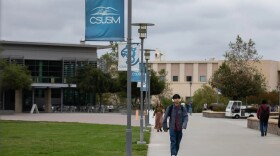The San Diego Zoo’s prolific koala population is getting a boost from a local biotech company working to unlock the secrets hidden in the animal’s genomes.
Illumina is teaming up with the San Diego Zoo Wildlife Alliance to help conservationists understand the animal’s susceptibility to pernicious cancers like lymphoma and leukemia.
The fuzzy gray animals with blunt noses first arrived at the San Diego Zoo in 1925 and the colony here is the largest outside of Australia. The animals spend most of their life sleeping. In San Diego that typically means they are in a tree-like habitat with a metal roof to help protect them from the elements.
“They give them heat in the winter. They give the misters in the summertime when the temperatures get really high,” said Lisa Martin, a wildlife care supervisor at the zoo.
When koalas do wake it is usually to munch on eucalyptus leaves, the only thing the Australian natives eat.
And they are full of surprises.

“They can move fast,” Martin said. “I didn’t recognize it, but they can jump horizontally six feet. And I did not recognize that they’re not always cute and cuddly. They have their own personalities as well.”
But koalas also have an endemic health issue. A Koala retrovirus (KoRV) has inserted itself into the animal’s DNA, making the marsupials susceptible to a number of pernicious cancers.
“Almost all koalas are infected with one or more Koala retroviruses and this viral infection is a problem for koalas because it predisposes them to develop some very specific secondary diseases,” said Cora Singleton, Senior Veterinarian at the San Diego Zoo Wildlife Alliance.
Specifically, KoRV can cause lymphoma and leukemia and the retrovirus is linked to Chlamydia and Cryptococcus infections. Because the animals are good at hiding illnesses — a survival trait developed in the wild — caregivers typically don’t realize an animal is sick until the cancers are advanced.
“I and everyone on the team have struggled with the devastating effects of leukemia and lymphoma in our population,” Singleton said. “It can strike animals as young as 2 1/2 years old and it’s heartbreaking.”
Singleton hopes understanding more about the marsupial’s DNA will allow wildlife officials to better manage koala populations. That requires knowing more about the retroviruses and where the virus has initiated mutations in each individual’s DNA strand.
That requires a map of koala DNA.

“Whole genome sequencing, while it was available just a couple of years ago, was very expensive and very time consuming. And so it wasn’t within our reach,” Singleton said.
That has changed. What was unattainable a few years ago is now in reach, said Illumina Vice President Ashley Van Zeeland. The company is offering its services through Illumina’s iConserve program aimed at preserving wildlife and habitats. The company would not disclose the financial details of the arrangement.
“Since that very first human genome sequence that took 10 years of a global consortia that spent almost $3 billion dollars to put together, our latest sequencing platform, the NovaSeq X can do 48 genomes in two days, or even more, the price point is about $200 dollars for a whole human genome,” Van Zeeland said.
The speed of processing combined with the falling cost has already resulted in the sequencing of more than 90 koalas.

Illumina is working to broaden the nascent species database by sequencing tissue from both living koalas and from koalas that are long dead.
The company processes tissue samples that come from the San Diego Zoo Wildlife Alliance’s frozen zoo.
“When it comes to understanding the consequence of a genomic sequence you really need both, large numbers of genomes to tease out when you have an A mutated to a G or you have a certain gene disrupted,” Van Zeeland said. “It’s a lot of information so you need many, many samples to make a conclusion about the consequence of that DNA change. You also then need to have that coupled with the clinical information.”
And the Zoo has that clinical information.
“Every koala in our care. We know its parents. We know its grandparents. We know its great-grandparents. And that’s a really important part of this project. Looking at the ancestry of these koalas,” Singleton said.

The retrovirus cannot be excised because it is part of a koala’s DNA, but understanding which KoRV mutations lead to which illnesses allows caregivers to make better conservation decisions.
“We hope to be able to use the information that we learn from the genome, and the specific places where the Koala retrovirus is in the genome,” Singleton said. “To understand which koalas would pair together and produce the most healthy and resilient offspring.”
That can help minimize the risk of illness in a captive population, and even allow conservationists to be better stewards of wild koala populations in Australia.
The DNA information could help keep animals with dangerous mutations out of populations that currently do not have them.







